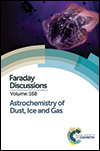Exploring the origins of carbon in terrestrial worlds†
Abstract
Given the central role of carbon in the chemistry of life, it is a fundamental question as to how carbon is supplied to the Earth, in what form and when. We provide an accounting of carbon found in solar system bodies, and in particular a comparison between the organic content of meteorites and that in identified organics in the dense interstellar medium (ISM). Based on this accounting, identified organics created by the chemistry of star formation could contain at most ∼15% of the organic carbon content in primitive meteorites and significantly less for cometary organics, which represent the putative contributors to starting materials for the Earth. In the ISM ∼30% of the elemental carbon exists as CO, either in gaseous form or in ices, with a typical abundance of ∼10−4 (relative to H2). Recent observations of the TW Hya disk find that the gas phase abundance of CO is reduced by an order of magnitude compared to this value. We explore an explanation for this observation whereby the volatile CO is destroyed via gas phase processes, providing an additional source of carbon for organic material to be incorporated into planetesimals and cometesimals. This chemical processing mechanism requires warm grains (>20 K), partially ionized gas, and sufficiently small (agrain < 10μm) grains, i.e. a larger total grain surface area, such that freeze-out is efficient. Under these conditions, static (non-turbulent) chemical models predict that a large fraction of the carbon nominally sequestered in CO can be the source of carbon for a wide variety of organics that are present as ice coatings on the surfaces of warm pre-planetesimal dust grains.
- This article is part of the themed collection: Astrochemistry of Dust, Ice and Gas

 Please wait while we load your content...
Please wait while we load your content...